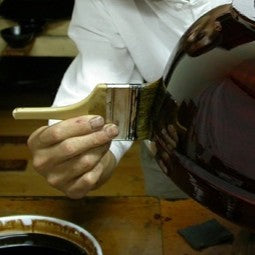
옻칠 Ottchil: 2,000 Years of Korean Lacquer Art
For over two millennia, Korea has preserved the profound artistry of Ottchil (옻칠) — the traditional craft of lacquering using the sap of the lacquer tree. More than just a decorative finish, Ottchil embodies the wisdom of nature, refined aesthetics, and durability that have carried it into modern times.
What Is 옻칠 Ottchil?
Ottchil is one of the oldest Korean traditional crafts, created by coating wooden, ceramic, or metal objects with the natural sap of the lacquer tree. Once dried, this natural coating becomes eco-friendly, non-toxic, and highly durable, providing exceptional resistance to water, insects, decay, and even acids. Its deep gloss, subtle fragrance, and ability to grow more beautiful with age make it superior to synthetic finishes.
In East Asia, lacquerware developed uniquely across regions:
- China excelled in carved lacquer (조칠, diaoqi).
- Japan perfected maki-e (蒔繪), decorating lacquer with gold and silver powder.
- Korea, however, became world-renowned for mother-of-pearl inlaid lacquerware (Najeonchilgi, 나전칠기), which reached its height during the Goryeo dynasty .
A 2,000-Year Legacy
Archaeological finds confirm that Ottchil has been used in Korea for nearly two thousand years. Artifacts from the Changwon Dahori site, dating to around the turn of the Common Era, reveal some of the earliest lacquered objects.
During the Three Kingdoms period (57 BCE–668 CE), lacquerware appeared in royal tombs and Buddhist relics, including Baekje pillow rests, Silla gilt-bronze bottles, and wooden vessels.
By the Unified Silla era (668-935), lacquered tableware and containers were excavated from Anapji.
In the Goryeo dynasty (918-1392), Najeonchilgi reached unprecedented artistic refinement, so prized that even Chinese envoys noted its excellence in the Goryeo Dogyeong (高麗圖經), written by the Chinese envoy Xu Jing in 1123.
The Joseon dynasty (1392–1897) continued this tradition, producing a wide range of lacquered household objects — from chests and boxes to sewing kits and headrests — embedding lacquerware into daily life.
Types of Lacquerware
The base material defines the name and character of each piece:
- Moksim-chilgi (wood-core lacquerware)
- Juksim-chilgi (bamboo-core)
- Geonchil or Hyeopjeo-chilgi (cloth-core, made with hemp or ramie)
- Jiseung-chilgi (paper-twisted core)
- Watae or Dotae-chilgi (ceramic core)
- Geumtae-chilgi (metal core)
- Chilpi-chilgi (leather core)
Among these, Geonchil (cloth-core lacquerware) required exceptional skill and durability, often used in Buddhist statues.
The Process of Ottchil
The art of Ottchil demands patience and precision. Craftsmen apply layer after layer of natural lacquer — sometimes over 20 stages — allowing each coat to cure under specific humidity and temperature conditions.
Unlike synthetic coatings, pure Ottchil preserves the natural grain of wood. Over time, it develops a soft sheen and depth that make each vessel feel alive. Because of this, lacquerware was historically reserved for temples, rituals, and noble households.
🎥 Watch the process of Ottchil here
A Living Tradition
Today, Ottchil is preserved by Korean Intangible Cultural Heritage holders. Master artisan Donho Lee (이돈호) of Daejeong Workshop in Gangwon Province continues this legacy, creating exquisite pure Ottchil woodenware. His works celebrate the quiet elegance of lacquer, carrying forward a tradition that bridges the ancient and the contemporary.

How to Care for Ottchil Lacquerware
To preserve the timeless beauty of Ottchil pieces:
- Treat lacquerware like a precious jewel. Avoid prolonged exposure to direct sunlight or heat, which may cause warping or discoloration.
- Do not soak in water. Instead, wash gently with a soft sponge or cloth. A mild detergent may be used if necessary.
- Clean separately from other tableware to prevent scratches.
- After washing, dry immediately with a soft cloth to maintain its luster.
- Avoid sudden temperature changes. Never use in microwaves, ovens, dishwashers, or on direct heat.
With proper care, Ottchil becomes not only a functional item but also a lasting heirloom that grows more beautiful over generations.
